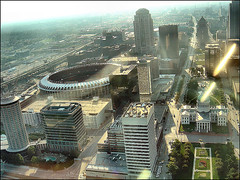More on St. Louis

Posted June 26, 2008 at 1:31PM
Last week I wrote about the extraordinary restoration of the Old North Saint Louis neighborhood. This week, my thoughts have been more on the massive flooding that has come to the Mississippi River valley, including areas close to Saint Louis. It is the second “500-year flood” in the valley in only 15 years.
I’ll return to that, but we also have some more good news to report on Saint Louis: its designation as one of the National Civic League’s All-American cities for 2008, on the strength of its downtown recovery.
 Nationally syndicated columnist Neal Peirce puts it this way in his current column:
Nationally syndicated columnist Neal Peirce puts it this way in his current column:
“Eleven years ago, Washington Avenue in St. Louis was declining rapidly, the downtown prospects grim. And the rest of the St. Louis region didn't seem to care.
“So in a 1997 series for the St. Louis Post-Dispatch, my Citistates Group co-author Curt Johnson and I arbitrarily picked 2010 as the year foreigners might come poking through the ruins of Washington Avenue. They'd be witnessing, we suggested, the tragic endpoint of the heedless flight of Americans from their once-proud cities.
“The good news is how wrong we were. Reel forward (or back!) to this June 6. The yearly competition for one of the National Civic League's coveted All-America City awards is taking place in Tampa, Fla. There's huge suspense -- which cities (out of 100 original entries) will a jury select to receive the awards?
“St. Louis makes the cut, receiving its first All-America City award since 1956. And what's the top talking point St. Louis used to win? It's the downtown, focus of our dire warning of 1997.”
“As Richard C.D. Fleming, president of the St. Louis Regional Chamber and Growth Association and a leader in getting the Missouri Legislature to pass the credit explains: 'The total new investment in downtown is almost $5 billion. And close to 90 percent of it is historic preservation -- great old structures rehabilitated for offices, condos and more -- not just a bunch of new megastructures.'
“The downtown residential population, close to zero in 1997, is up to 10,000, and growing.
“But St. Louis, for decades bedeviled by deep population losses and widely scattered suburban sprawl, also won its award by pointing to a stunning regional advance. It's the new River Ring project, which eventually will be a 600-mile web of 45 biking trails and greenways designed to encircle and connect the entire region -- a big 'green' advance and also a way to help metro St. Louis compete with other areas in environmentally friendly outdoor life.”
The comeback of America’s central cities – now well-documented – is one of the great stories of the young 21st century, and not just for smart growth. Read Neal’s entire column here.
Back to the flooding, the US Climate Change Science Program warns us that, due to human-caused global warming, we are likely to see more extreme weather events of all types:
“In the future, with continued global warming, heat waves and heavy downpours are very likely to further increase in frequency and intensity. Substantial areas of North America are likely to have more frequent droughts of greater severity. Hurricane wind speeds, rainfall intensity, and storm surge levels are likely to increase. The strongest cold season storms are likely to become more frequent, with stronger winds and more extreme wave heights.”
Ugh. Here's what Mississippi River flooding in Des Moines looked like two weeks ago:
The silver lining is that urban redevelopment in places like Old North and downtown St. Louis helps limit flooding, because it displaces new growth and pavement that would otherwise spread out into currently well-performing watersheds. Runoff from new residential areas has been estimated at up to 10 times that of pre-development conditions, and runoff from new commercial development has been estimated at 18 times that before development.
Urban redevelopment also reduces greenhouse gas emissions, by offering alternatives to driving and shorter driving distances for those who do drive. The city of St. Louis appears to be doing its part, in more ways than one. May the good examples keep coming.
